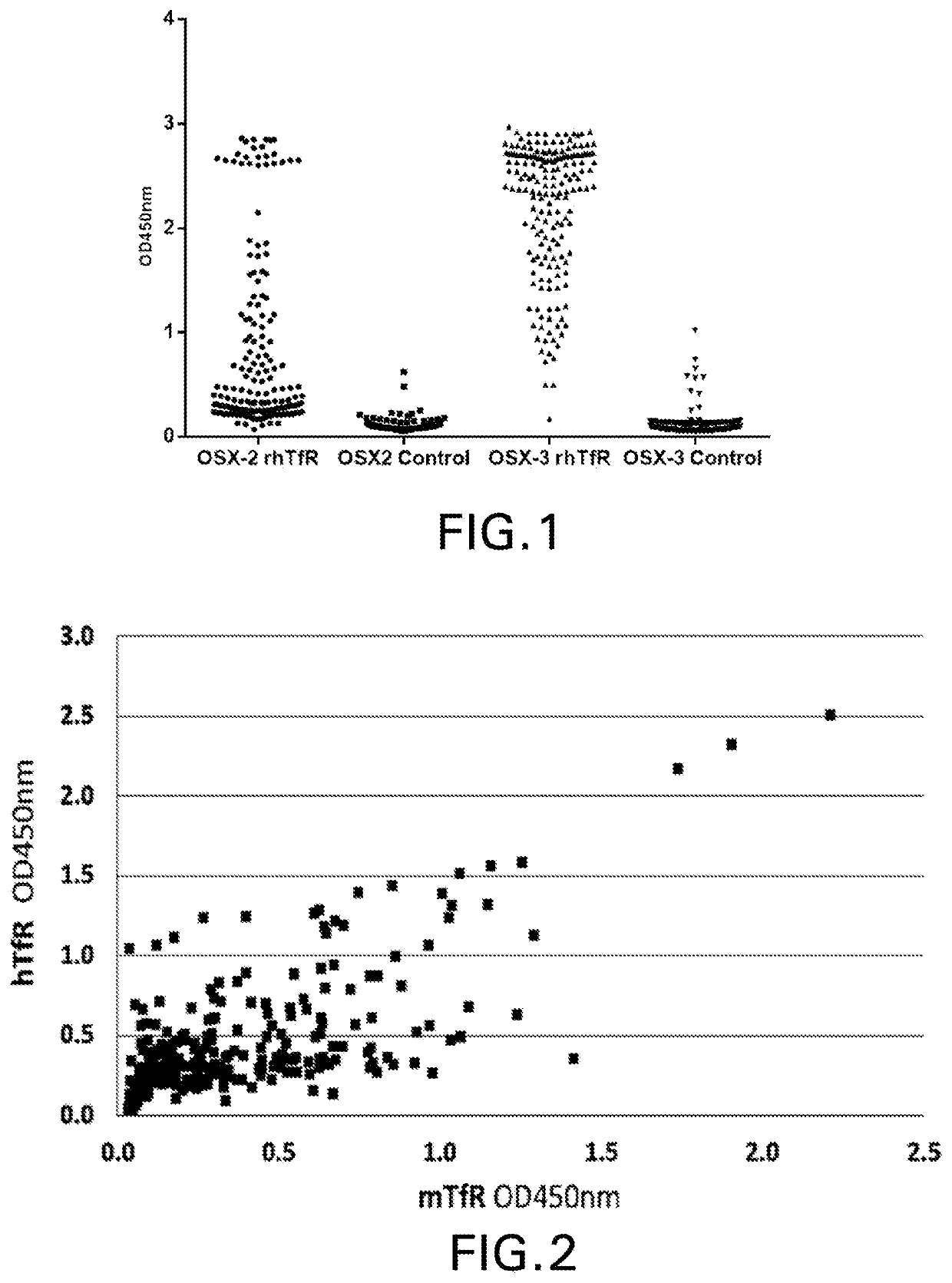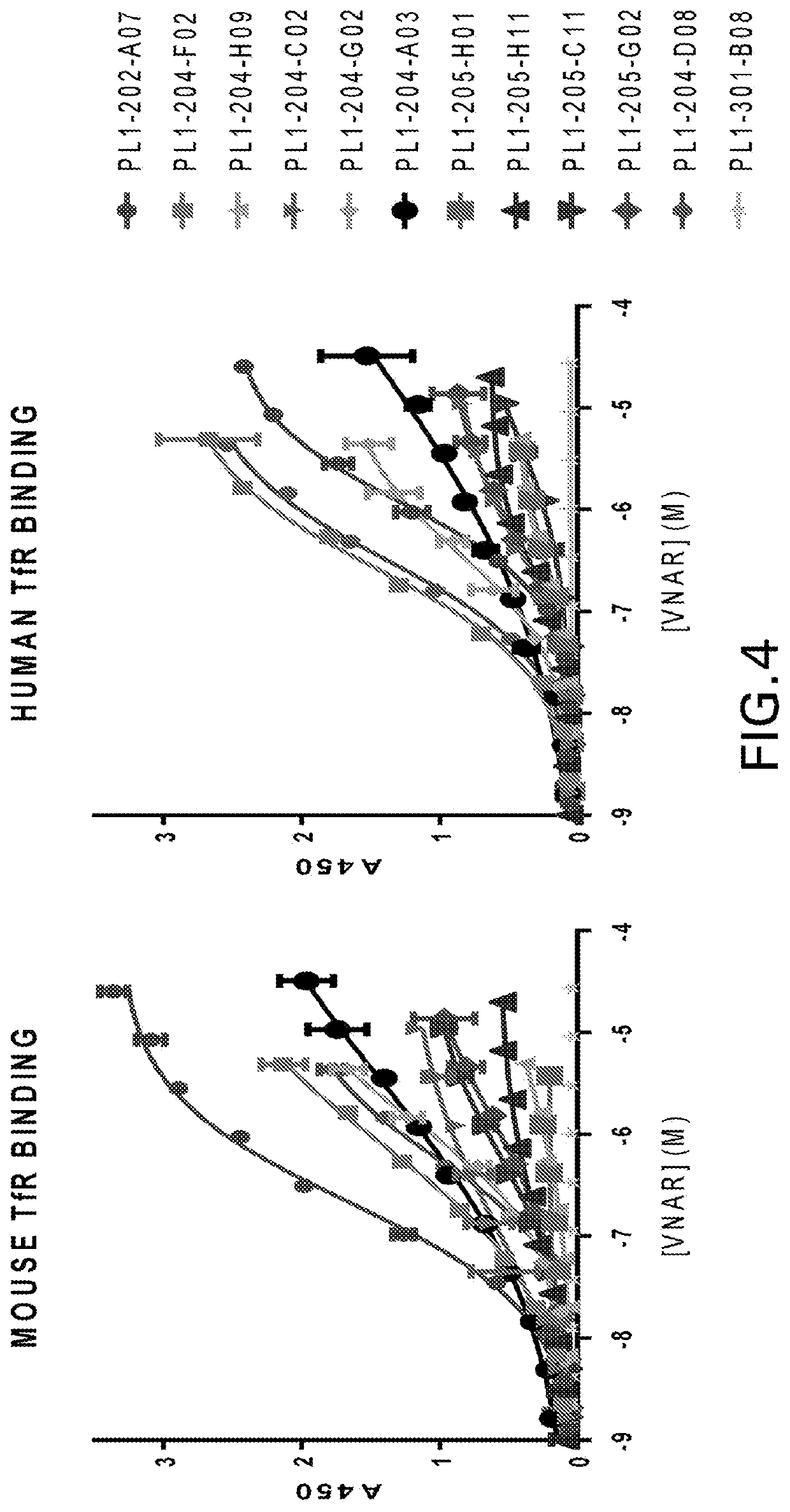TfR SELECTIVE BINDING COMPOUNDS AND RELATED METHODS
a selective binding and compound technology, applied in the field of peptides, can solve the problems of inability to reach many of the antibodies designed to treat a variety of neurodegenerative disorders including alzheimer's disease, huntington's disease, frontotemporal dementia, and many will be successful developed without an effective means of delivery across the bbb, so as to increase the oral bioavailability of drugs
- Summary
- Abstract
- Description
- Claims
- Application Information
AI Technical Summary
Benefits of technology
Problems solved by technology
Method used
Image
Examples
example 1
ethods
[0227]A1. Phage Display Selection of VNARs Having TfR-Binding Properties
[0228]The phagemid vector used for both phage display and monomeric VNAR expression is pOsD2, a modified version of pSEX81 (Progen) in which a 6×His tag (SEQ ID NO: 483), a FLAG tag, and an amber stop codon were inserted between the VNAR (inserted into SfiI sites) and the full-length PIII protein of the M13 phage (the PCT '166 appln.).
[0229]Three different semi-synthetic VNAR libraries were panned including a wobbegong shark library OSX-2 (complexity 6.8×109 CFU) constructed as previously described (Nuttall et al., Mol Immunol. 2001 August; 38(4):313-26) and the OSX-3 and OSX-4 synthetic libraries (described in the PCT '166 appln.). The phagemid vector used for both phage display and monomeric VNAR expression is pOsD2, a modified version of pSEX81 (Progen) in which a 6×His tag (SEQ ID NO: 483), a FLAG tag, and an amber stop codon were inserted between the VNAR (inserted into SfiI sites) and the full-length...
example 2
l Selections for TfR-1-Binding VNARs
[0245]Libraries were also selected for pH-sensitivity by binding the phage to plates coated with human Tf-1, washing at pH 7.2 and eluting the bound phage with buffer at pH 5.2 for 2-3 rounds of panning.
[0246]Additionally, 2-3 rounds of panning were performed by internalization using TfR-1 expressing cell lines as previously described with minor modifications (Poul et al., J Mol Biol. 2000 Sep. 1; 301(5):1149-61). Libraries were enriched by a single round of solid-phase panning on rhTfR-1 prior to cell-based selections. A negative selection was carried out for 60 min. at 4° C. using adherent MX-1 human breast cancer cells (Cell Lines Service GmbH) prior to adding the deplete library to either mouse bEnd.3 (ATCC, CRL-2299) or human SKOV 3 cells (ATCC, HTB-77). To recover phage from within the cell, surface-bound phages were removed with low pH glycine and trypsin before lysing the cells in 100 mM triethylamine. Recovered phages were rapidly neutral...
example 3
Analysis of TfR-1-Binding VNARs
[0248]VNAR inserts were sequenced by the dye termination method with an automated sequencer (Applied Biosystems) their corresponding amino acid aligned using Clustal W 2.0 and Clustal X 2.0 programs (Larkin et al., Bioinformatics 2007 Nov. 1; 23(21):2947-8). Framework and CDR regions were identified by reference to known VNAR structures and unique and related clones were identified by amino acid sequence of the CDR3 and CDR1 regions.
PUM
| Property | Measurement | Unit |
|---|---|---|
| MW | aaaaa | aaaaa |
| covalent or non-covalent linkage | aaaaa | aaaaa |
| fluorescent | aaaaa | aaaaa |
Abstract
Description
Claims
Application Information
 Login to View More
Login to View More - R&D
- Intellectual Property
- Life Sciences
- Materials
- Tech Scout
- Unparalleled Data Quality
- Higher Quality Content
- 60% Fewer Hallucinations
Browse by: Latest US Patents, China's latest patents, Technical Efficacy Thesaurus, Application Domain, Technology Topic, Popular Technical Reports.
© 2025 PatSnap. All rights reserved.Legal|Privacy policy|Modern Slavery Act Transparency Statement|Sitemap|About US| Contact US: help@patsnap.com



